Remote Work Statistics – By Region, Industry, Benefits, Demographics, Working Location and Influential Factors
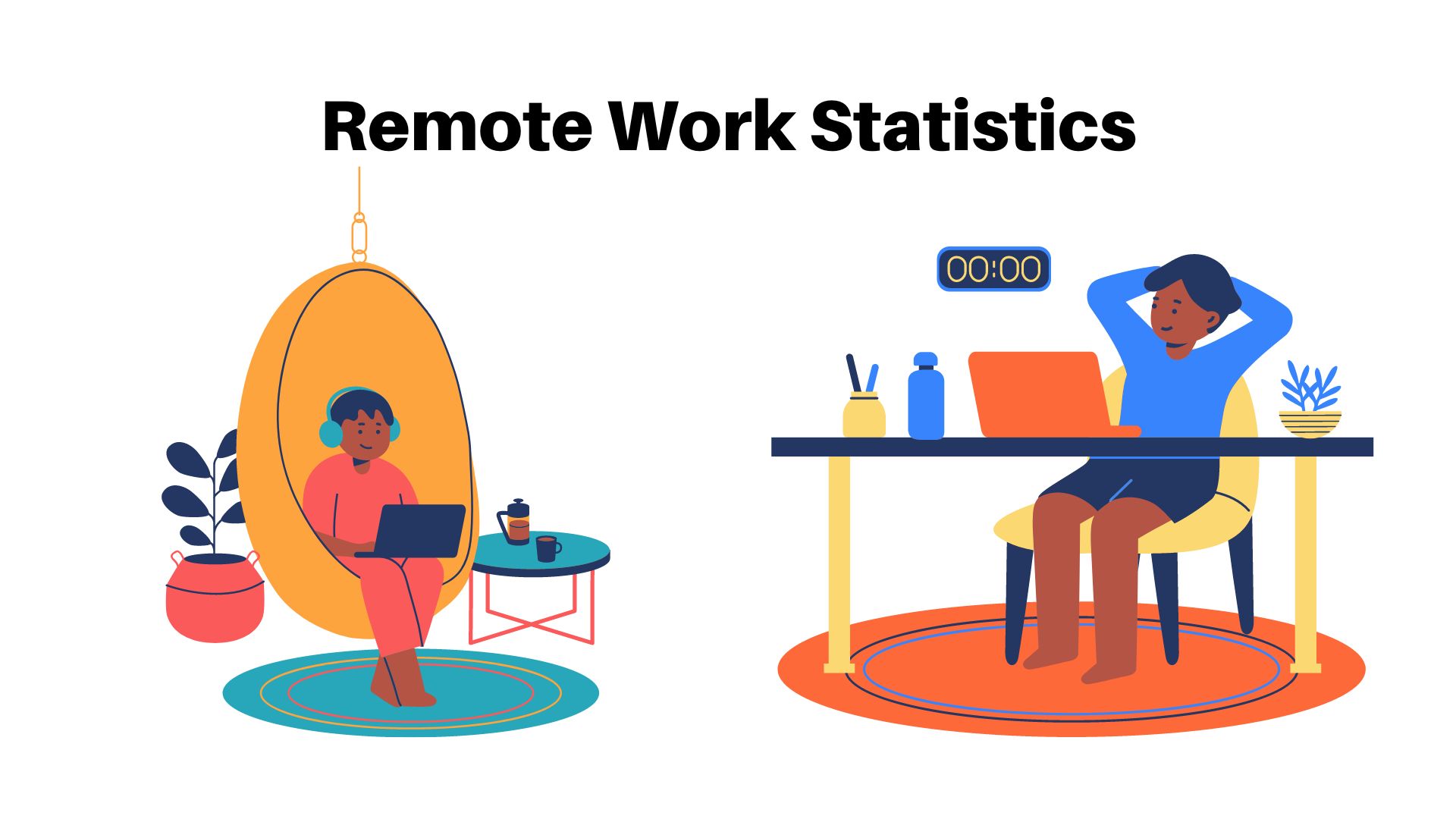
Page Contents
- Introduction
- Editor’s Choice
- What is remote work?
- Facts About Remote Work
- Benefits of Remote Work
- General Remote Work Statistics
- Remote Work Statistics By WFH Tools
- Why do employers use monitoring software?
- Remote Work Statistics By Structure
- Remote Work Statistics By Retention Rate
- Remote Work Statistics By Working Location
- Remote Work Statistics By Influential Factors
- Remote Work Statistics By Region
- Remote Work Statistics By Industry
- Remote Work Statistics By Demographics
- Remote Work Statistics By Problems
- Remote Work Statistics By Remote Work Options
- Remote Work Statistics By Benefits
- Remote Work Statistics By Sleep Schedule
- Conclusion
Introduction
Remote Work Statistics: The future is here we say, as technology made sure to let employees spread around the globe to work remotely. Just before the pandemic people commuting to offices daily shifted to completely mobile work opportunities. Market reports of distance work state that the future of remote work will be adopted by many companies soon as employees focus on such job opportunities only.
These Remote Work Statistics are written from various aspects that need to be taken into consideration while setting policies for mobile work.
Editor’s Choice
- Mobile workers with communicative employers are 5X more productive and 3X less feel burned out.
- 25% of remote employees are planning to change their locations for a better lifestyle.
- Around 55% of Americans believe their work can be performed remotely in their industry.
- Remote work statistics say that, in May 2021, remote work job postings on LinkedIn increased by 350%.
- Remote work Statistics state that in the year 2022, the remote workplace market was valued at $20.1 billion, and it is projected to reach 58.5 billion by the year 2027 at a CAGR of 23.8%.
- 59% of distance employees said, their office is functional in 2 to 5 various times zones.
- For every mobile work employee companies save around $22K every month, on the other hand, employees save on average $4000 every year due to a reduction in commute.
- In the upcoming years, employers are planning to spend more on remote work tools as well as virtual manager training.
- 16% of people say that they are worried about their company not allowing mobile work once the pandemic ends.
- On average, women are more like to work remotely than men as stated by Remote Work Statistics.
What is remote work?
Work from anywhere, mobile work, distance work, or telework are collectively called Remote work. Since COVID-19, companies around the globe increased remote work opportunities. Even if the pandemic is to end, employees are going to prefer remote. Many times, remote work and work from home have collaborated, but these two terms are different. Remote work is completely remote, the employee works from wherever he/she wants to and is not expected to visit office premises. Moreover, employees could be spread across the globe. On the other hand, in the case of working from home, is more of a hybrid work. Employees are in the same state as the company’s location and must visit the office at least once or twice a week or as told by their companies.
Facts About Remote Work
- Remote Work offers equal pay as on-site offered salary packages.
- Mobile work is not only for IT-based positions, but also other sectors are applicable.
- You don’t need any specific qualification to work from home, rather, if your qualifications are matching to job role then depending on the company’s policies you are eligible to do remote work.
- All remote jobs are not flexible, in some cases, you are required to work at a designated time.
- You can use your e-device to complete office work, it is not always required to have an office device.
Benefits of Remote Work
For Employees
- Decreased office politics.
- Increase in efficiency of work.
- Increase in the bonding with colleagues spread around the world.
- Perfect work-life balance.
- Increased productivity and performance.
- Decrease in the impact on the environment.
- Possibilities to earn more money.
- Opportunities to connect with diverse people.
- Availability of more opportunities
- Employees can work from anywhere, even on vacations.
- Decrease in spending on fuels.
- More time with family.
- Available time to do extracurricular activities.
For employers
- Decrease in conflicts.
- Increased possibility to create a team of talented employees.
- Low level of carbon footprint.
- Better disaster management.
- Increase employee retention.
- Increase in employee satisfaction.
- Easier recruitment process.
- Global talent search opportunities.
- Decrease in spending of cost on employees.
General Remote Work Statistics
- Only 5% of executives believe in having fully remote offices to strengthen the company culture.
- Remote work statistics say that, in May 2021, remote work job postings on LinkedIn increased by 350%.
- Around 55% of Americans believe their work can be performed remotely in their industry.
- In the upcoming years, employers are planning to spend more on remote work tools as well as virtual manager training.
- For every mobile work employee companies save around $22K every month, on the other hand, employees save on average $4000 every year due to a reduction in commute.
- Mobile workers with communicative employers are 5X more productive and 3X less feel burned out.
- 77% of remote workers believe they feel productive while working remotely.
- If remote employees are not regularly monitored, then team building can decrease by 25%.
- 42% of employees face problems with setting boundaries while being remote from the office.
- 16% of people say that they are worried about their company not allowing mobile work once the pandemic ends.
- According to Remote Work statistics, 33% of employees said if mobile work opportunity is not provided, they might leave the job
- 84% of employees are willing to work from anywhere in the future.
- 59% of distance employees said, their office is functional in 2 to 5 various times zones.
- 25% of remote employees are planning to change their locations for a better lifestyle.
- Remote work Statistics state that in the year 2022, the remote workplace market was valued at $20.1 billion, and it is projected to reach 58.5 billion by the year 2027 at a CAGR of 23.8%.
- On average, women are more like to work remotely than men as stated by Remote Work Statistics.
- As of January 2022, New Jersey was awarded the best state to work remotely.
- Around the globe, 82% of managers are allowing their employees to work remotely.
- Workforce Happiness Index is higher for remote workers
- According to Remote Work statistics, around 74% of companies spread around the globe are planning to provide permanent mobile work.
- 80% of employees said they will recommend working remotely to their friends.
- 83% of candidates decline job opportunities if it does not have any flexible working system.
- Around the world, as of today, 16% of companies are remote.
Remote Work Statistics By WFH Tools
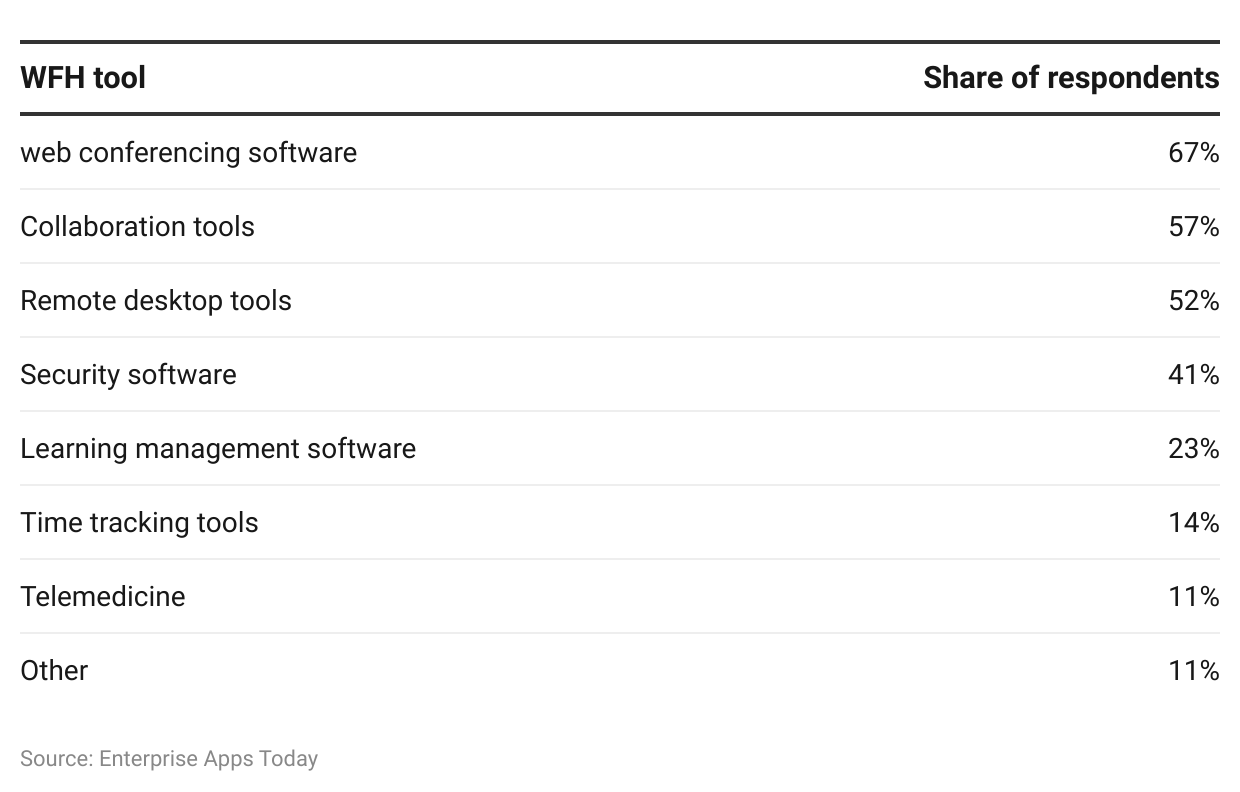
(Reference: explodingtopics.com)
- As of 2022, Remote Work Statistics states the business spending made by remote companies resulting in the highest number of spending on Web conferencing software at 67%.
- Other tools on which various companies spent their money are as follows: Collaboration tools (57%), Remote desktop tools (52%), Security software (41%), Learning management software (23%), Time tracking tools (14%), Telemedicine (11%) and other related software (11%).
Why do employers use monitoring software?
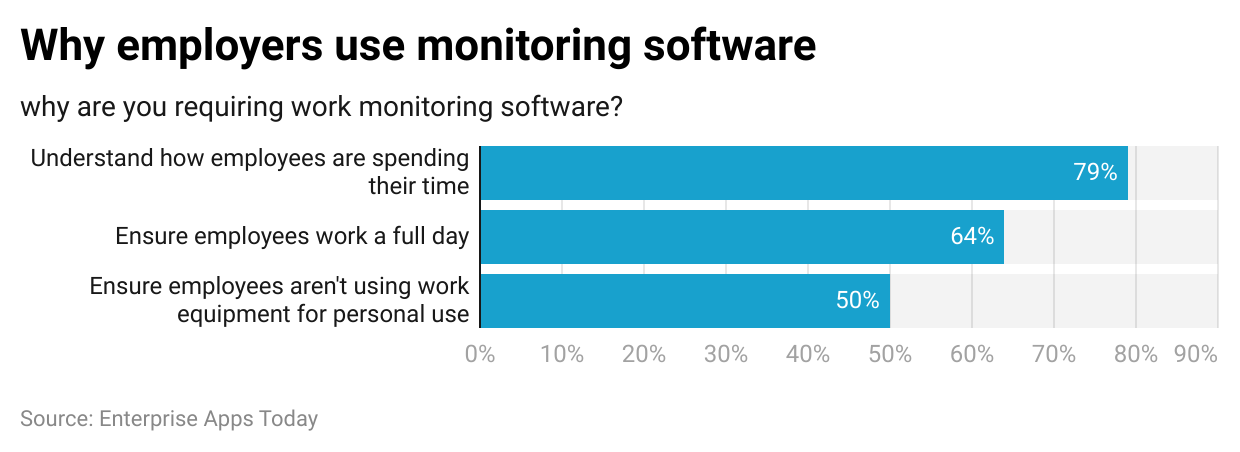
(Reference: explodingtopics.com)
- According to Remote Work Statistics, 79% of employers use monitoring software because they want to understand how employees spend their time during office hours.
- Around 64% of employers want to know if their employee is working a full day or not.
- Furthermore, 50% of the companies make sure that their office equipment is not used for personal use.
Remote Work Statistics By Structure
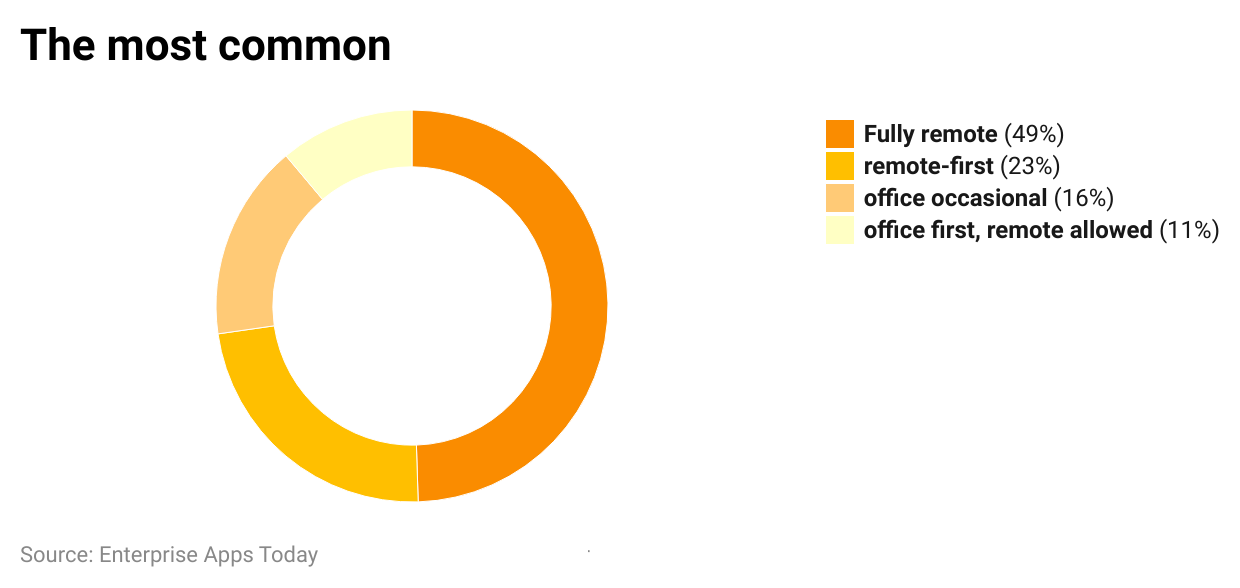
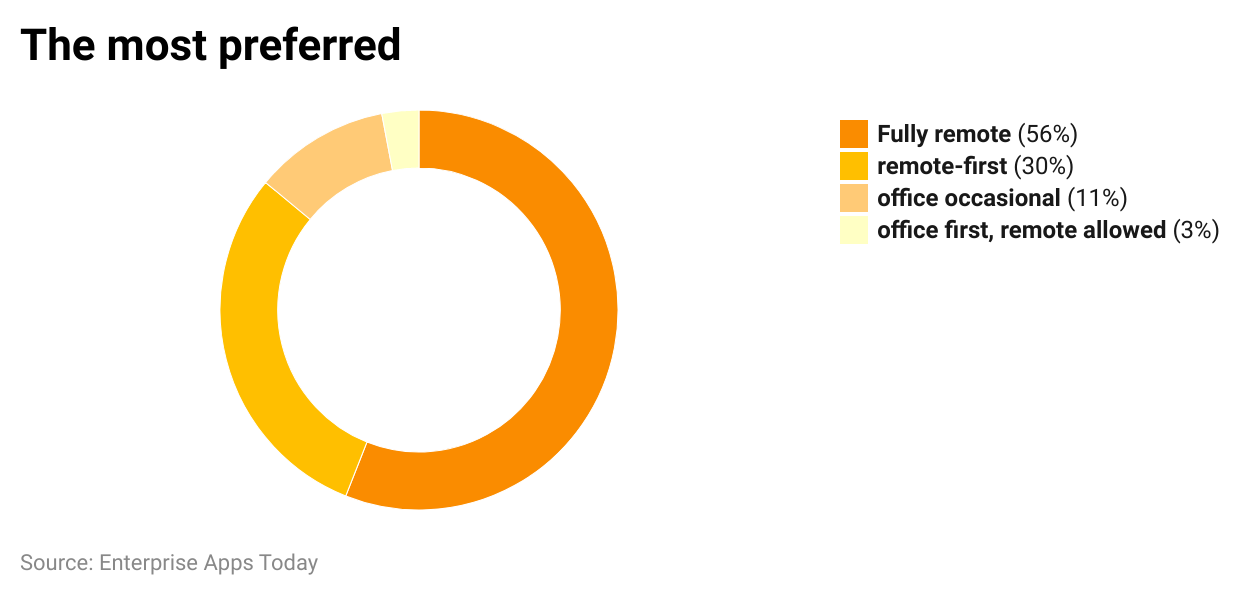
(Reference: pumble.com)
- The most common factors told by employees that influence the job acceptance rates are fully remote (49%), remote-first (23%), occasional office (16%), and office first, remote allowed (11%).
- And the most preferred factors by candidates while applying for a job are fully remote (56%), remote-first (30%), occasional office (11%), and office-first but remote facility allowed (3%).
Remote Work Statistics By Retention Rate
- Around the world, 65% of employees are willing to become full-time remote workers.
- Remote employees are 13% more likely to stay in the same job than onsite employees.
- 57% of the remote workers are more likely to mark their job as satisfied than onsite employees resulting in 50%.
- 81% of employees said that they would be loyal to their employer if remote opportunities are offered.
Remote Work Statistics By Working Location
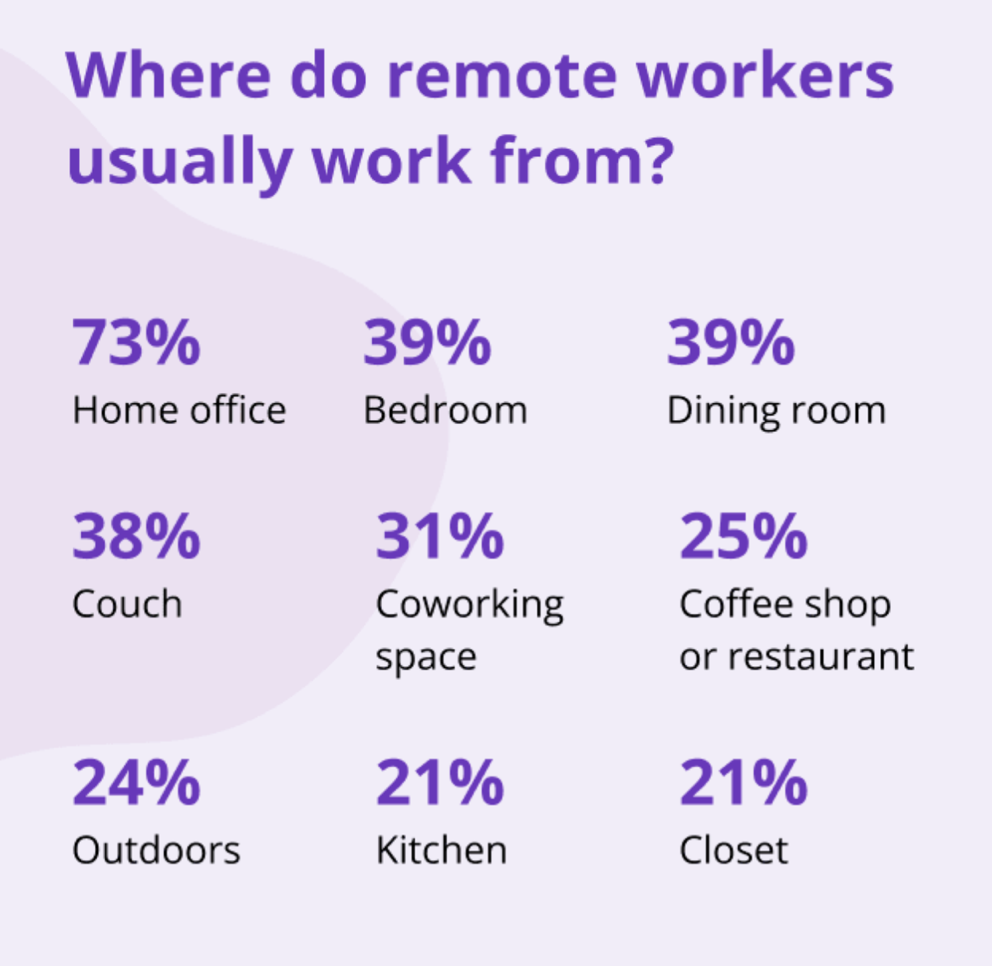
(Reference: pumble.com)
- An interesting fact about Remote Work Statistics is there are multiple locations where remote workers love to work from. Following is insights into those locations.
- Home office (73%), Bedroom (39%), Dining room (39%), Couch (38%), Coworking Space (31%), Coffee Shop or restaurant (25%), Outdoors (24%), Kitchen (21%), and Closet (21%).
Remote Work Statistics By Influential Factors

(Reference: flexjobs.com)
- Other Remote Work Statistics of influential factors that affect the choice of mobile work are – Remote work options (84%), Salary (81%), Work-Life balance (79%), Work Schedule (56%), Meaningful work (50%), Company culture (42%), Skills training and education options (40%), Career growth (40%), Vacation time (38%) and Company reputation (38%).
Remote Work Statistics By Region
- According to the Mobile work statistics of 2022, on a global average, 40% of the companies were very prepared to shift their locations to a remote workforce, while 53% reported somewhat prepared and 6% were not pred at all.
- Furthermore, region-wise allocation of preparedness to shift working style into remote workforce states the following:1
APJC
- Very prepared (39%)
- Somewhat prepared (54%)
- Not prepared (7%)
AMER
- Very prepared (39%)
- Somewhat prepared (55%)
- Not prepared (6%)
Europe
- Very prepared (45%)
- Somewhat prepared (50%)
- Not prepared (6%)

(Reference: bloggingwizard.com)
Remote Work Statistics By Industry
The following chart explains the total number of workers in the United States with the ability to work remotely in the year 2022. It has been observed that the top three occupations which were able to work remotely were Web developers (78.2%), Lawyers (61.6%), and Computer and mathematical occupations (52.5%).
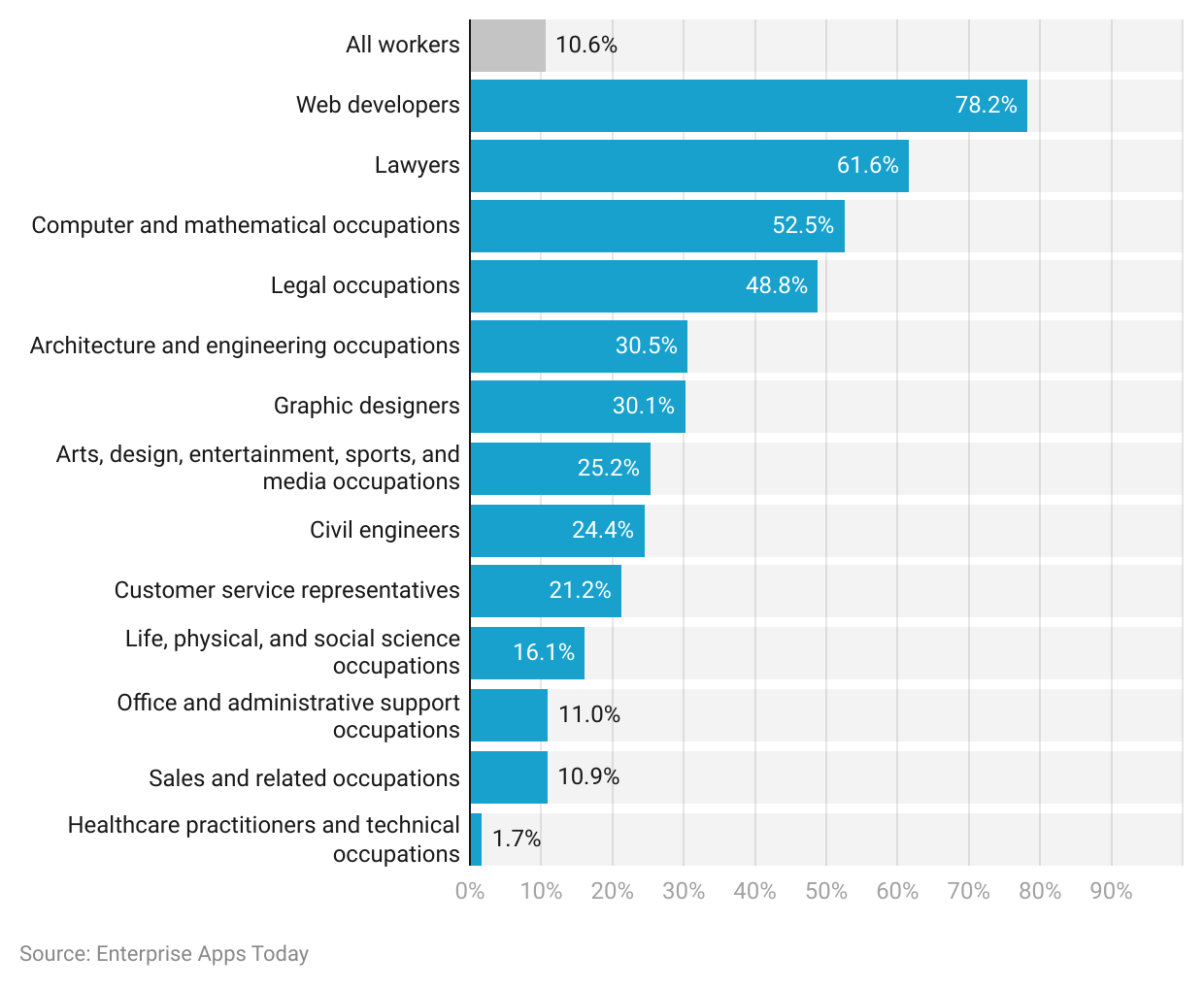
(Reference: Statista.com)
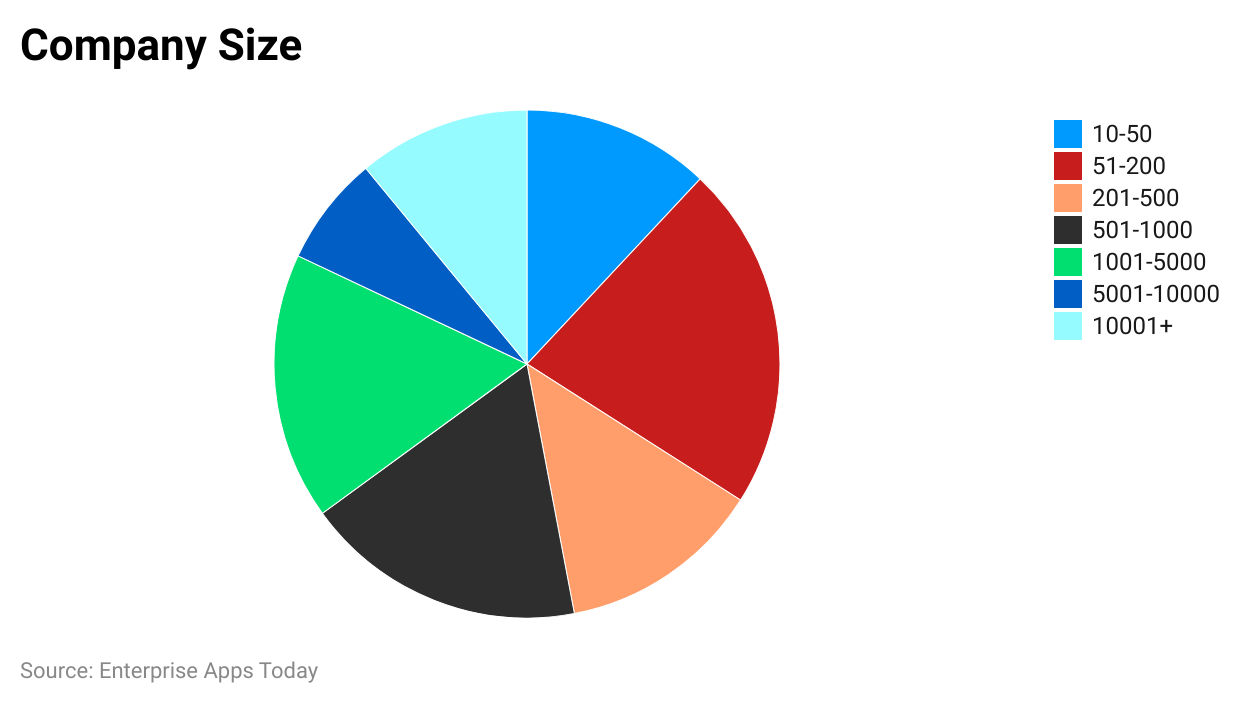
- As of 2022, there were 12% of employees working remotely in a company that had a 10 – 50 employee count.
- Similarly, 22% and 13% were in companies with 51- 200 and 201 – 500 employee count working remotely.
- Further recorded insights from 2022 are 501- 1000 (18%), 1,001 – 5,000 (17%), 5,001 – 10,000 (7%), and 10,000 and above (11%).
Remote Work Statistics By Demographics
By Education Level
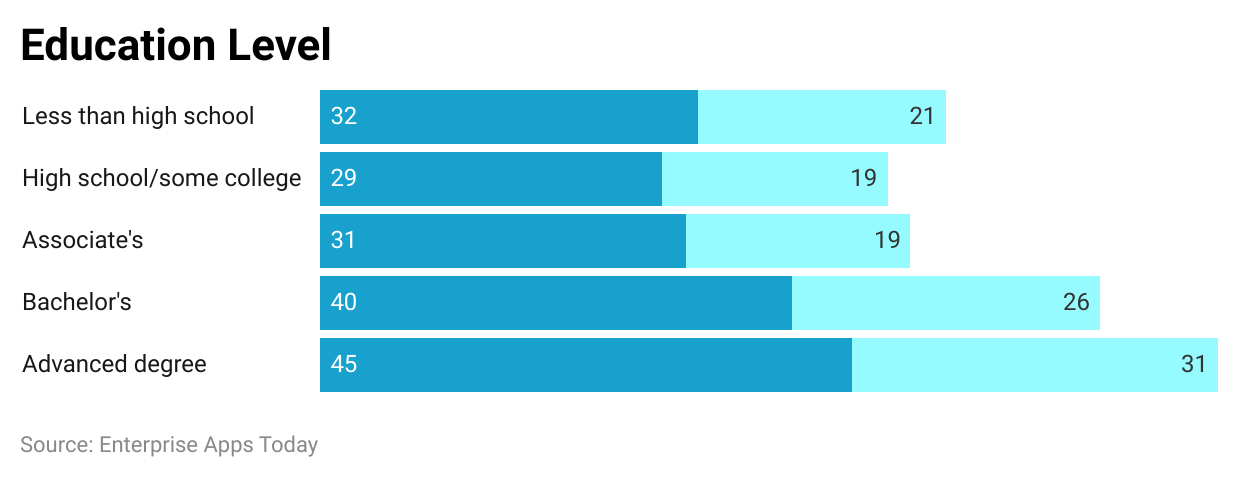
(Reference: mckinsey.com)
- 32% of remote full-time and 21% of remote part-time employees had less than high school level education.
- Similarly, 29% and 19% of the respective category had some high school/ college level knowledge.
- On the other hand, 31% and 19% earned associate degrees while 40% and 26% had their bachelor’s degrees.
- The highest number of 45% of full-time remote workers and 31% of part-time remote workers had advanced degrees.
By Income Level
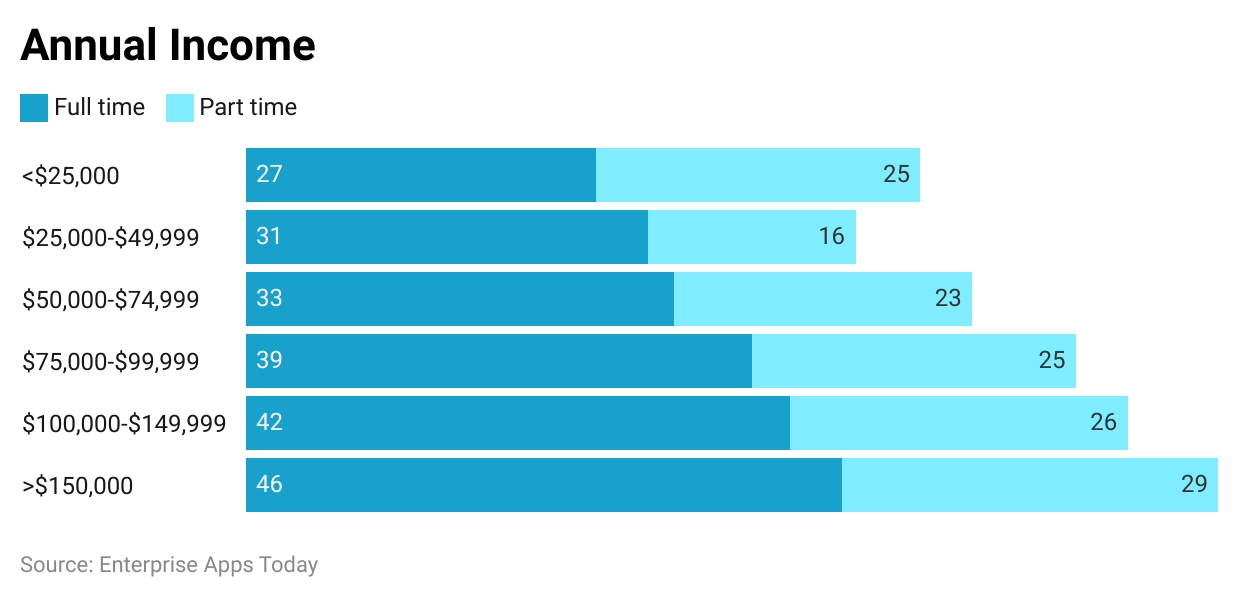
(Reference: mckinsey.com)
- According to Remote Work Statistics, there were around 27% of full-time and 25% of part-time remote employees had a salary range of less than $25,000 per annum.
- There were respectively 31% and 16% with a salary range of $25,000 to $49,999.
- Similarly following salary bracket shows the respective remote workers in the United States of America as of 2022 – $50,000 to 74,999 Full time (33%), Part-time (23%), $75,000 to $99,999 Full time (39%), Part-time (25%),$100,000 – $149,000 Full time (42%), Part-time (26%), and $150,000 and above Full time (46%), Part-time (29%).
By Ethnicity
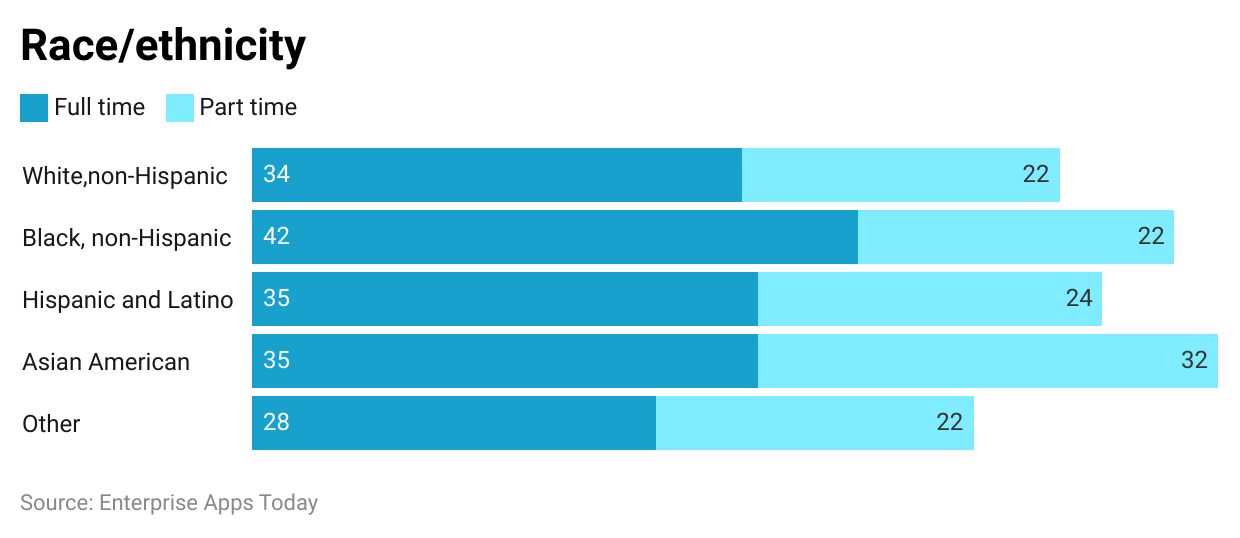
(Reference: mckinsey.com)
- As of 2022, in the United States of America, there were 34% full-time remote workers and 22% part-time remote workers from the white non-Hispanic ethnic background.
- 42% of full-timers and 22% of part-timers working remotely belonged to black, non-Hispanic groups.
- Similarly, 35% equally full-time remote workers belong respectively to Hispanic and Latino, and Asian American backgrounds, on the other hand, 24% and 32% of part-timers reported being from a similar ethnic background.
- 28% and 22% of full-time and part-time remote workers were from other races.
By Age
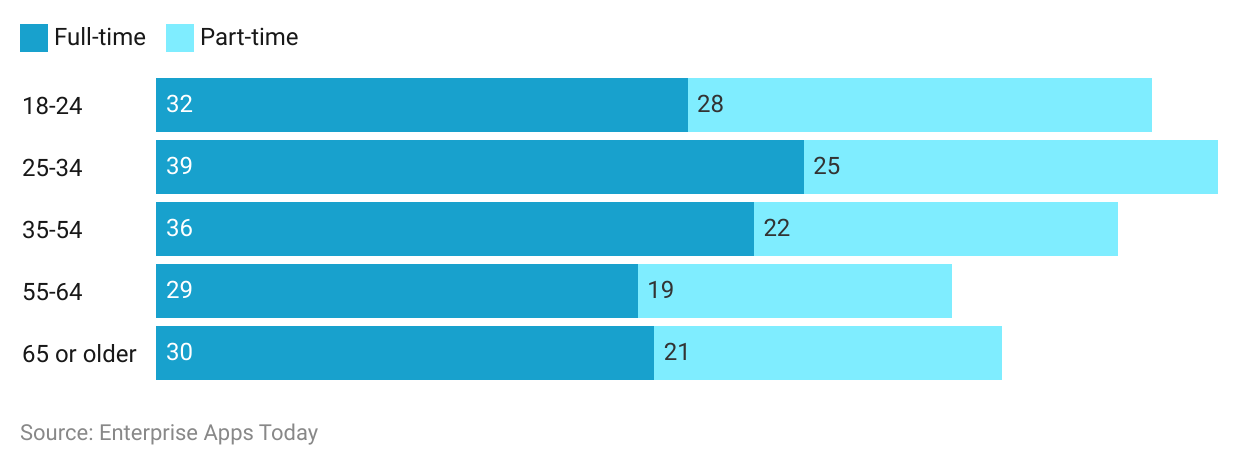
(Reference: mckinsey.com)
- The Remote Work Statistics of demographic by age state that, 32% of workers between 18 to 24 worked remotely full time while 28% of them were part-time remote workers.
- Similarly, there were 39% of full-time remote workers and 25% of part-time mobile employees aged between 25 years to 34 years respectively.
- Furthermore, there were 36%, 29%, and 30% full-time remote workers aged respectively between 35 years to 54 years, 55 years to 64 years, and 65 years and above.
- On the other hand, 22%, 19%, and 21% reported doing remote part-time work in the United States of America as of 2022, aged between 35 years to 54 years, 55 years to 64 years, and 65 years and above.
By Gender
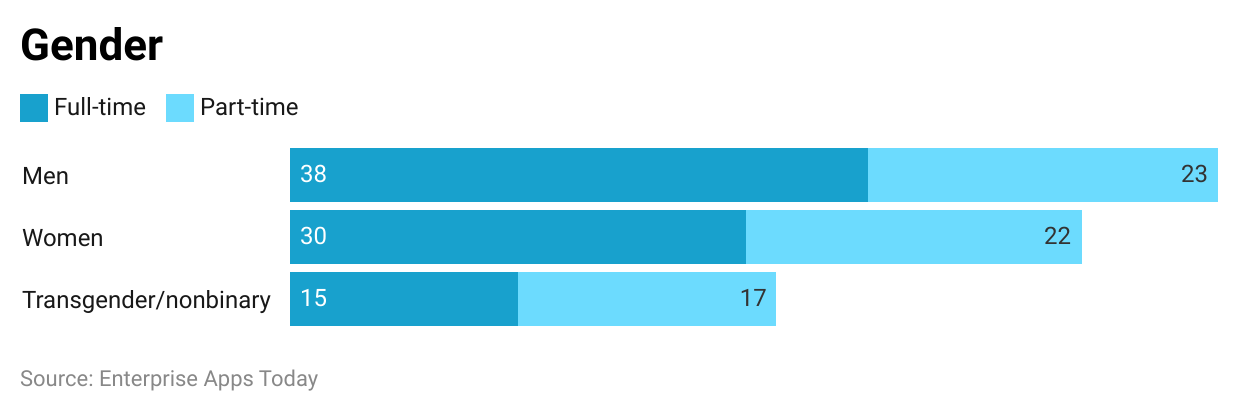
(Reference: mckinsey.com)
- Around the globe, as of 2022, in the United States of America, 38% of males and 30% of women were working full-time remotely.
- On the other hand, 23% of males and 22% of females reported working part-time remotely.
- And 15% and 17% transgenders were respectively working full-time and part-time completely remote.
Remote Work Statistics By Problems
| Problem | Share of people reporting it |
|---|---|
| Not being able to unplug | 25% |
| loneliness | 24% |
| Being in a different timezone than teammates | 21% |
| Staying Motivated | 21% |
| Difficulties with collaborating and communication | 17% |
| Other | 4% |
(Reference: demandsage.com)
- Another side of Remote Work Statistics said that 25% of the employees are not able to pull themselves out of the work environment.
- 24% stated that they felt loneliness and 21% of remote workers reported being in different time zones than teammates.
- 21% of remote employees struggled with keeping themselves motivated and, 17% had problems with collaboration and communication.
- And 4% of employees gave other reasons.
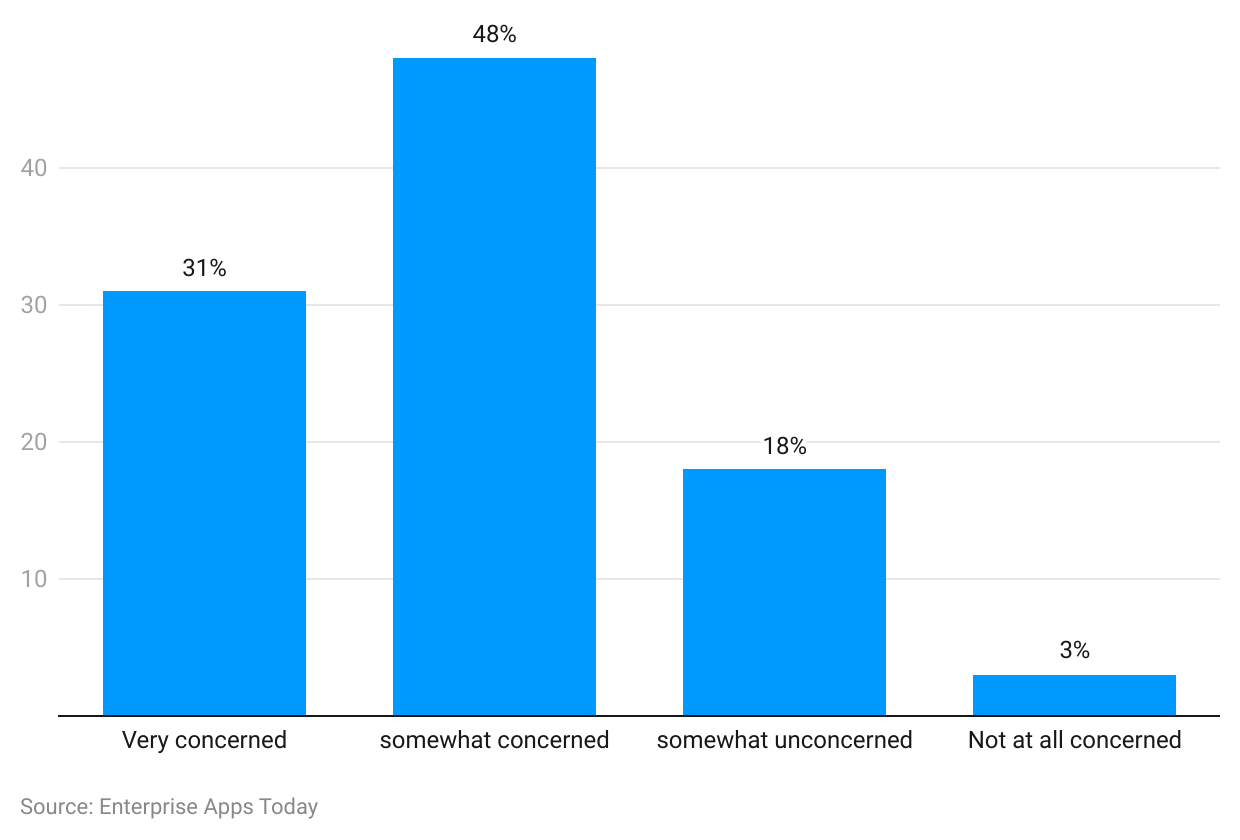
(Reference: Statista.com)
- As per the Remote Work Statistics, the above studies show levels of concern regarding remote work risks worldwide as of 2022.
- 31% of the employees are very concerned while 48% of remote workers are somewhat concerned.
- On the other hand, 18% are somewhat concerned and 3% are not concerned at all.
Remote Work Statistics By Remote Work Options
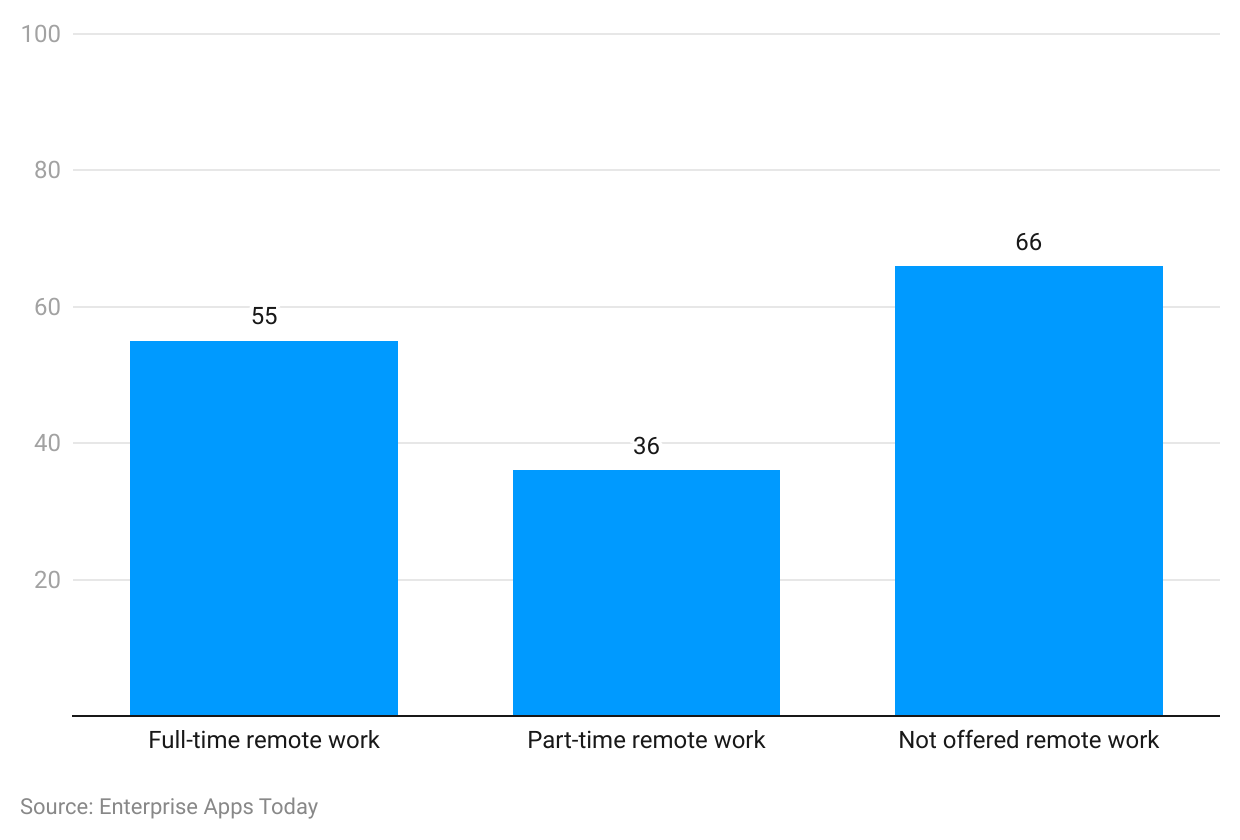
(Reference: Statista.com)
- In the United States of America as of 2022, 55 million employees are working full-time remotely.
- On the other hand, 36 million are part-time remote workers.
- 66 million of the employees were not offered remote work opportunities.
Remote Work Statistics By Benefits
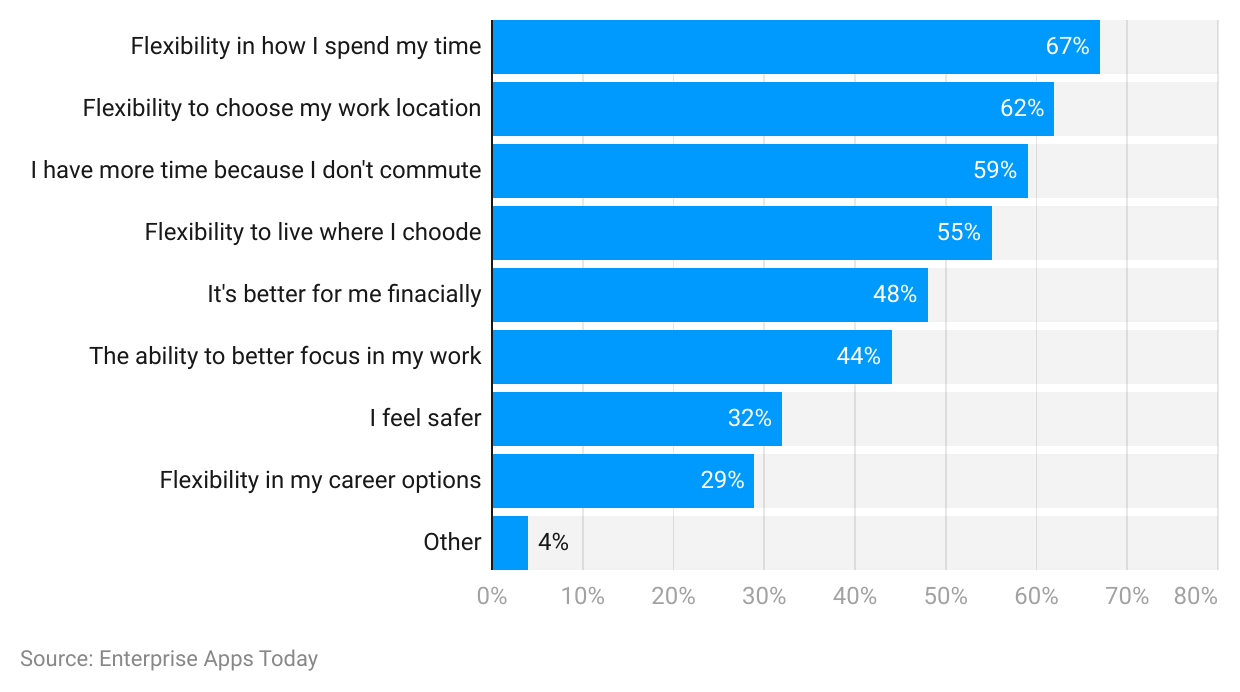
(Reference: Statista.com)
- According to the Remote Work Statistics of 2022, 67% of people said that the benefit of mobile work is the flexibility in how the time is spent.
- 62% of the remote employees stated the flexibility to choose the work location.
- Further remote work benefits stated by employees are more time because they don’t need to commute, the flexibility of location for living, and financial stability confirmed by 59%, 55%, and 48% respectively.
- Furthermore, 44% of the remote worker told they can focus on the work as well as 32% feel safe.
- 29% of the remotely working employees had flexible career options and 4% gave other reasons.
Remote Work Statistics By Sleep Schedule
- On average remote workers take 25 minutes to fall asleep at night.
- 75% of remote workers in government and public administration, as well as 70.2% of remote employees in marketing and advertising, said on average they get 7.1 hours of sound sleep.
- Similarly, 69.7%, 68.4%, and 67.2% of remote workers in information services and data processing, construction, and technology slept an average of 7.1 hours every night.
Conclusion
Concluding the Remote Work statistics, we came to know that, even though there is the upper hand in working mobile, drawbacks may include the hiring of some irresponsible employees, and increased investment in office equipment such as laptops, internet connection, etc. Moreover, keeping a track of employees spread across the world is kind of a tedious task.
Even though there’s cultural diversity but this could also become a major reason for conflicts. Women who work remotely, have to handle daily household also, therefore is causes stress and health-related issues. Despite these cons, remote working is another level of happiness!
Sources
FAQ.
Remote job postings are available on websites such as LinkedIn, Upwork, FlexJob, and GitHub. There are full-time, part-time as well as freelancing jobs related to remote work available.
Companies such as Allstate, Airbnb, 3M, DropBox, Hubspot, SAP, Shopify, Snowflake Inc., VMware, and 11 Press, are some of the companies providing remote work opportunities.
The following job roles provide opportunities to work completely remotely: 1. Writer, 2. Teacher, 3. Account Manager 4. Recruiter 5. Accountant, 6. Sales, 7. Email Marketer, 8. Attorney 9. Graphic Designer 10. Content Marketer 11. Social Media Manager 12. UX/UI Designer, 13. Product designer 14. Software engineer, 15. Web designer, 16. Editor and 17. Digital marketer.
On average, including any job role, a remote worker is eligible to earn between $32,342 to $37,762 a year.

Barry is a lover of everything technology. Figuring out how the software works and creating content to shed more light on the value it offers users is his favorite pastime. When not evaluating apps or programs, he's busy trying out new healthy recipes, doing yoga, meditating, or taking nature walks with his little one.